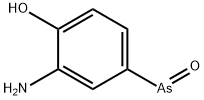Palladium dissolves in hot oxidising acids. Palladium is used as a hydrogenation catalyst, for H2/D2/T2separation and purification as well as a catalyst
in the Wacker process. The Wacker process, which facilitates the oxidation of ethylene to acetaldehyde, was
the first organopalladium reaction that was applied on an industrial scale.
This sulfhydryl-reactive arsenical (FW = 199.04 g/mol; CAS 306-12-7), variously named Mapharsen, Ehrlich-5, oxyphenarsine, oxarsan, arsinoxide, 3-amino-4-hydroxybenzenearsenoxide, and 2-amino-4-arsenosophenol, was originally developed by Nobelist Paul Ehrlich as an anti-syphilis drug. (Note: do not confuse this compound with oxophenylarsine, also known phenylarsine oxide). It is now used as an antiprotozomal agent, particularly against Trypanosoma. Oxophenarsine is typically supplied as the hydrochloride (FW = 235.50 g/mol) and is readily soluble in water. (See also Dichlorophenarsine) Target(s): acetyl-CoA acyltransferase; actomyosin ATPase; aldehyde dehydrogenase; alkaline phosphatase; asparagine synthetase; ATPase, rat brain; ATPase, trypanosomal; cathepsin; cholinesterase; deoxyribonuclease; diisopropylfluorophosphatase; γ-glutamyl hydrolase, or pteroylglutamate conjugase; glyceraldehyde-3-phosphate dehydrogenase; a-glycerophosphate oxidase; hexokinase; myosin ATPase; pyrophosphatase; pyruvate decarboxylase; pyruvate oxidase; ribose-5-phosphate isomerase; succinate dehydrogenase; succinate oxidase; urease.
